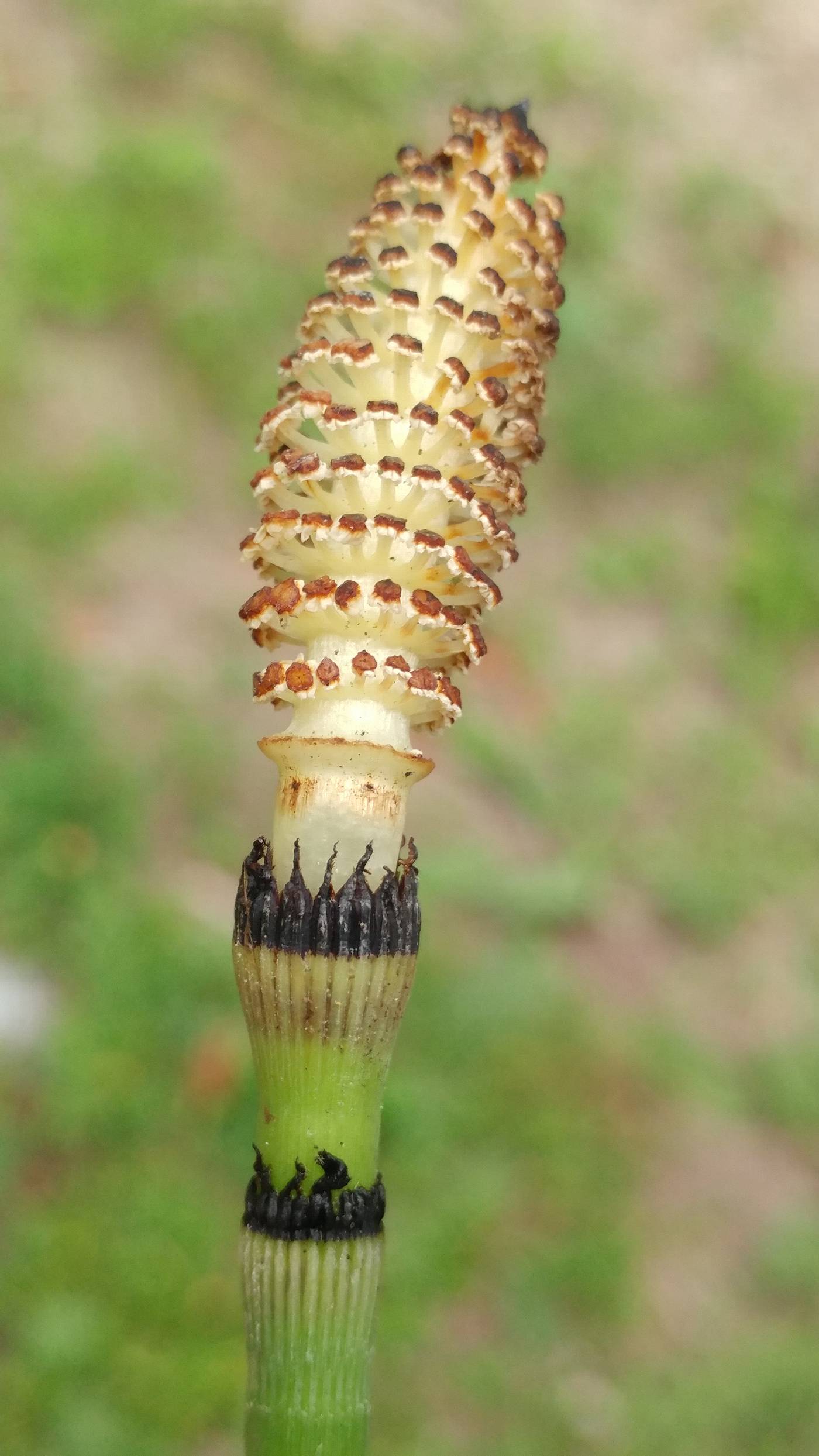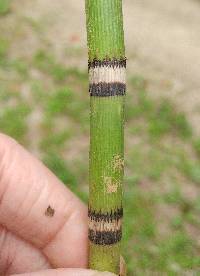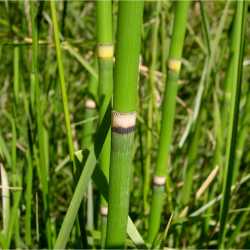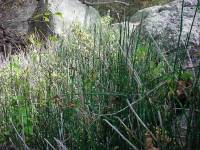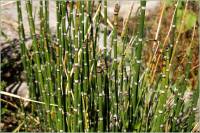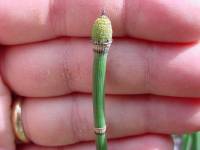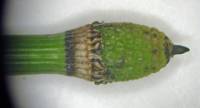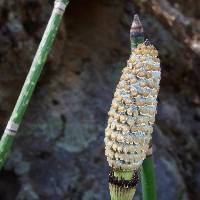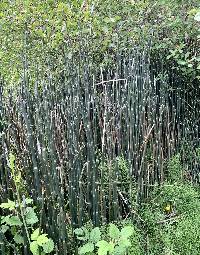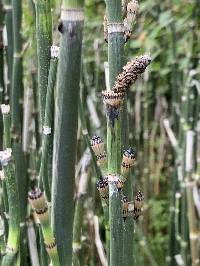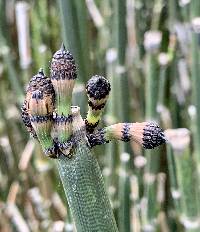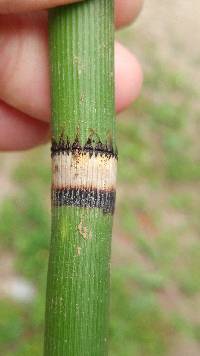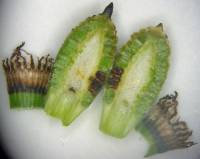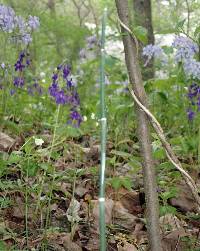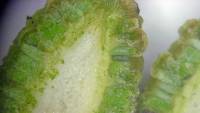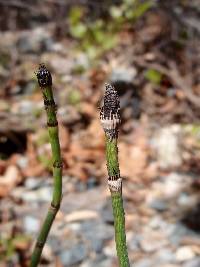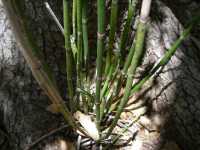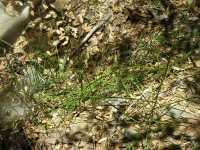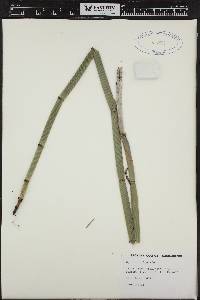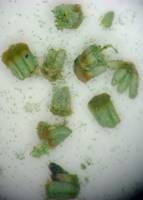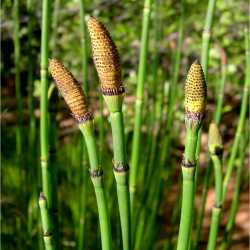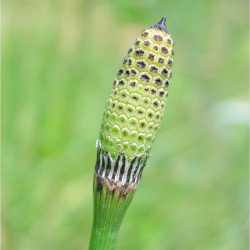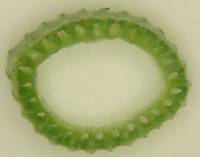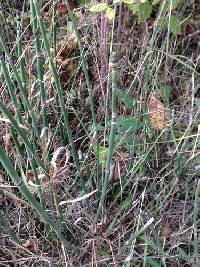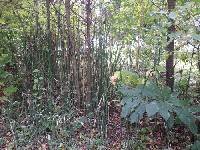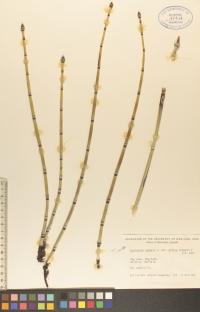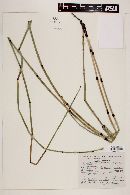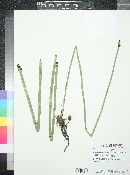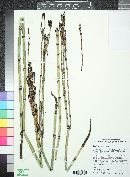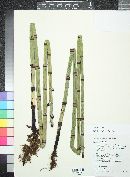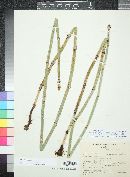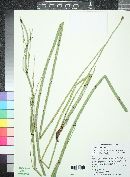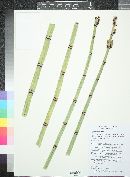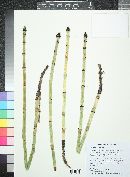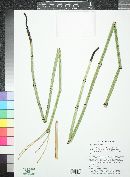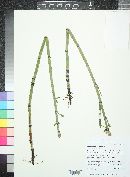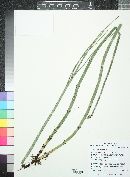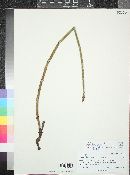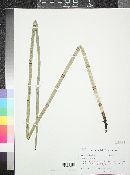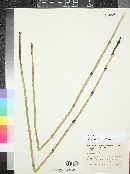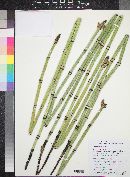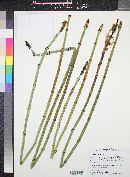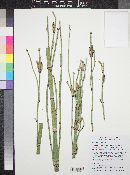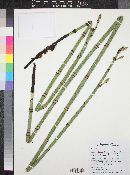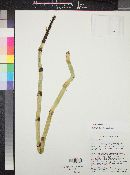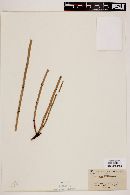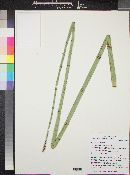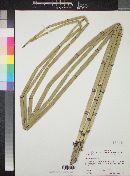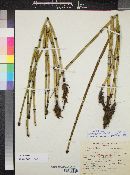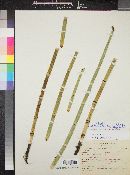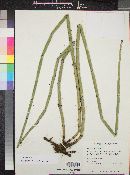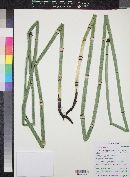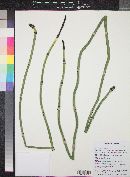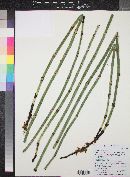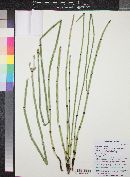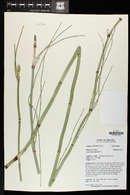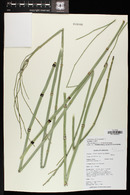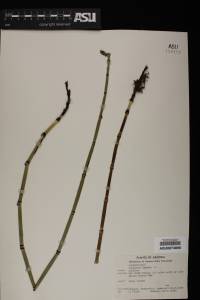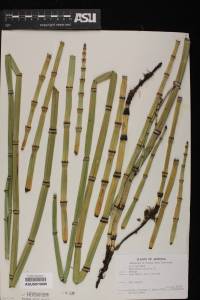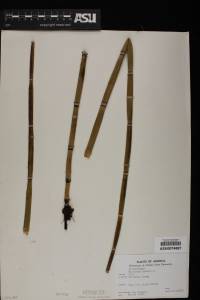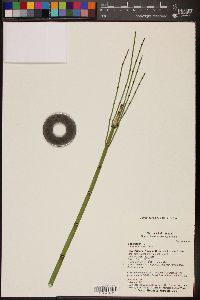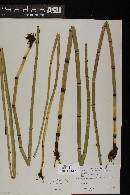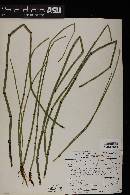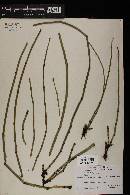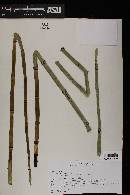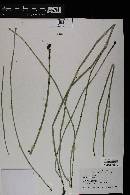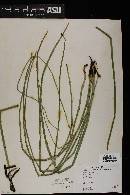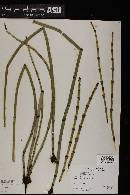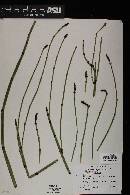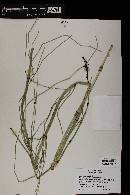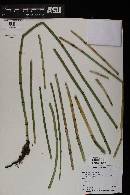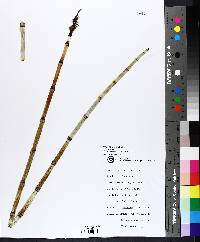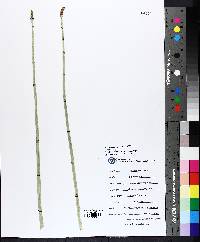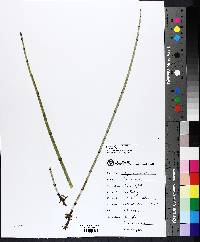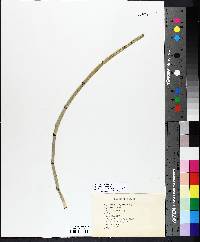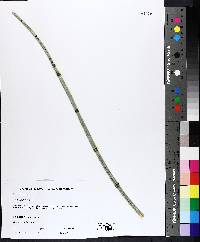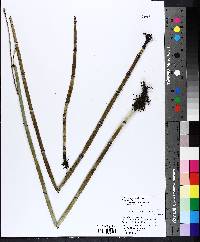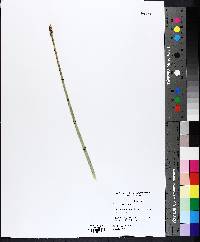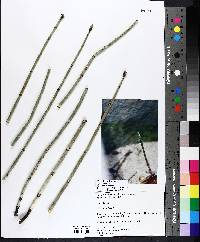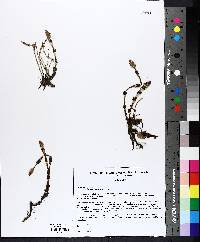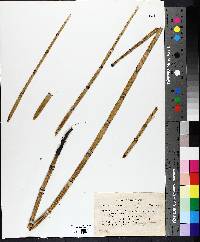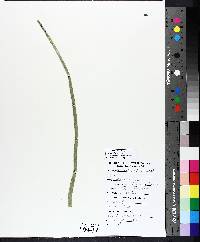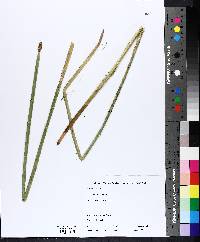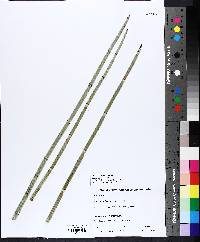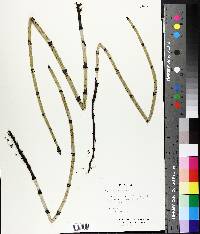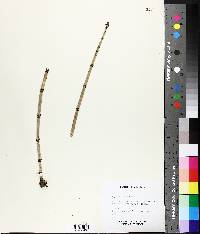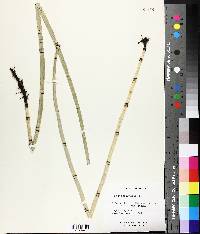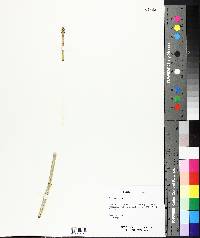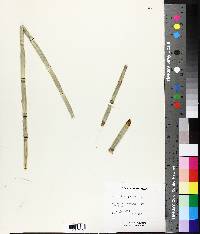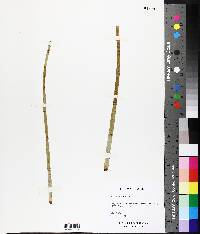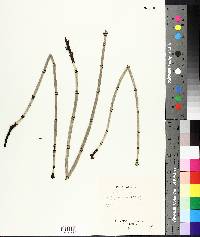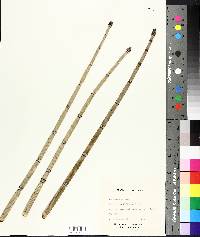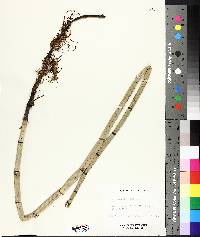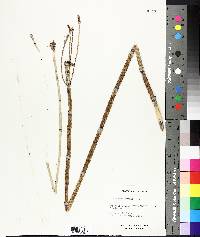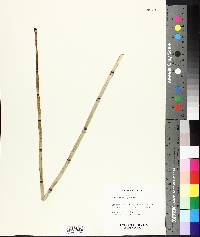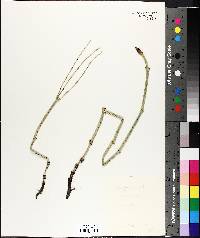Equisetum hyemale
|
|
|
|
Family: Equisetaceae
Tall Scouring-Rush, more...common scouringrush, scouring rush, horsetail, scouring horsetail, scouringrush, scouringrush horsetail, western scouringrush (es: carricitos, cañuela, cola de caballo)
[Equisetum hyemale var. ramigerum (Milde) Rouy] |
Subspecies 2 (1 in the flora): North America, Mexico, Central America in Guatemala, Europe, Asia. AERIAL STEMS: monomorphic, evergreen, 30-220 cm long, 14-50-ridged, erect (to prostrate after flooding), the surface somewhat roughened (sand-papery), usually dark green at maturity, unbranched or with irregular, scattered branches in wound-forms, these with 6-20 ridges. SHEATHS: as long as or slightly shorter than wide, variously marked with a dark basal band, a light gray to brown central band, and a dark tip, sometimes more or less uniformly darkened; teeth 14-50 per sheath (6-20 on branches), 2-4 mm long, gray to black. STROBILI: 8-25 mm long, the tips sharply mucronate. SPORES: 35-70 μm in diameter. 2n = 216. 2 subspp. [often treated as vars.]; N. Amer., C. Amer., Eur., Asia. REFERENCES: G.Yatskievych and M.D. Windham , 2008, Vascular Plants of Arizona: Equisetaceae. CANOTIA 4 (2): 41-45. General: Monomorphic, evergreen aerial stems, 30-220 cm long. Leaves: Erect stems, 14-50 ridged, surface roughened, usually dark green at maturity, unbranched or with irregular scattered branches where wounded, these with 6-20 ridges; sheaths as long or slightly shorter than wide, variously marked with dark basal band, a light gray to brown central band and a dark tip, sometimes more or less uniformly darkened, 4-50 teeth per sheath, 6-20 on branches, 2-4 mm long, gray to black. Sporangia: Terminal strobili 8-25 mm long, tips sharply mucronate. Ecology: Found in moist soil along streams and creeks, and in marshy meadows from 2,500-8,500 ft (762-2591 m); sporulates June-September. Notes: This species also has the infraspecific taxa ssp. affine, which is distinguished by the minute tubercles in 1 row along the ridges of the stems and with irregularly persistent teeth. Ethnobotany: Used as a horse medicine, taken for kidney problems, constipation, the leaves were burned as a disinfectant, used as an insecticide for washing hair, taken for irregular menstruation, for bladder or prostate pains, as a diuretic, as an eye wash, taken for diarrhea, gonorrhea, to help clear the system after childbirth, to speed up delivery, for sores, eaten as a food, used as fodder, for tools and basketry, mat weaving, and used as a ceremonial medicine. Etymology: Equisetum is from equus, horse and seta, bristle, while hyemale means of the winter, or flowering in winter. Sources: Yatskievych and Windham 2008 Yatskievych and Windham 2008 Common Name: scouringrush horsetail Wetland Status: FACW Rarity: None General: Monomorphic, evergreen aerial stems, 30-220 cm long. Leaves: Erect stems, 14-50 ridged, surface roughened, usually dark green at maturity, unbranched or with irregular scattered branches where wounded, these with 6-20 ridges; sheaths as long or slightly shorter than wide, variously marked with dark basal band, a light gray to brown central band and a dark tip, sometimes more or less uniformly darkened, 4-50 teeth per sheath, 6-20 on branches, 2-4 mm long, gray to black. Sporangia: Terminal strobili 8-25 mm long, tips sharply mucronate. Ecology: Found in moist soil along streams and creeks, and in marshy meadows from 2,500-8,500 ft (762-2591 m); sporulates June-September. Notes: This species also has the infraspecific taxa ssp. affine, which is distinguished by the minute tubercles in 1 row along the ridges of the stems and with irregularly persistent teeth. Ethnobotany: Used as a horse medicine, taken for kidney problems, constipation, the leaves were burned as a disinfectant, used as an insecticide for washing hair, taken for irregular menstruation, for bladder or prostate pains, as a diuretic, as an eye wash, taken for diarrhea, gonorrhea, to help clear the system after childbirth, to speed up delivery, for sores, eaten as a food, used as fodder, for tools and basketry, mat weaving, and used as a ceremonial medicine. Etymology: Equisetum is from equus, horse and seta, bristle, while hyemale means of the winter, or flowering in winter. Synonyms: None Editor: SBuckley, 2010 Stems all alike, evergreen, mostly unbranched, ±erect, 2-15+ dm, 4-14 mm thick, with mostly 16-50 broad, rounded, roughened ridges; central cavity at least 3/4 the diameter of the stem, much larger than the small vallecular ones; stomates in 2 rows in each furrow; sheaths mostly 5-15 mm, black-banded at the tip and usually also at or near the base, the dark, scarious-margined, basally connate teeth articulate to the sheath but tending to be irregularly subpersistent; cones short-pedunculate, 1-2.5 cm, evidently apiculate. Streambanks and other moist or wet places; circumboreal, s. in Amer. to Fla., Calif., and C. Amer. Amer. pls are var. affine (Engelm.) A. A. Eaton (E. affine; E. prealtum; E. robustum) Gleason, Henry A. & Cronquist, Arthur J. 1991. Manual of vascular plants of northeastern United States and adjacent Canada. lxxv + 910 pp. ©The New York Botanical Garden. All rights reserved. Used by permission. |
|
|
|

